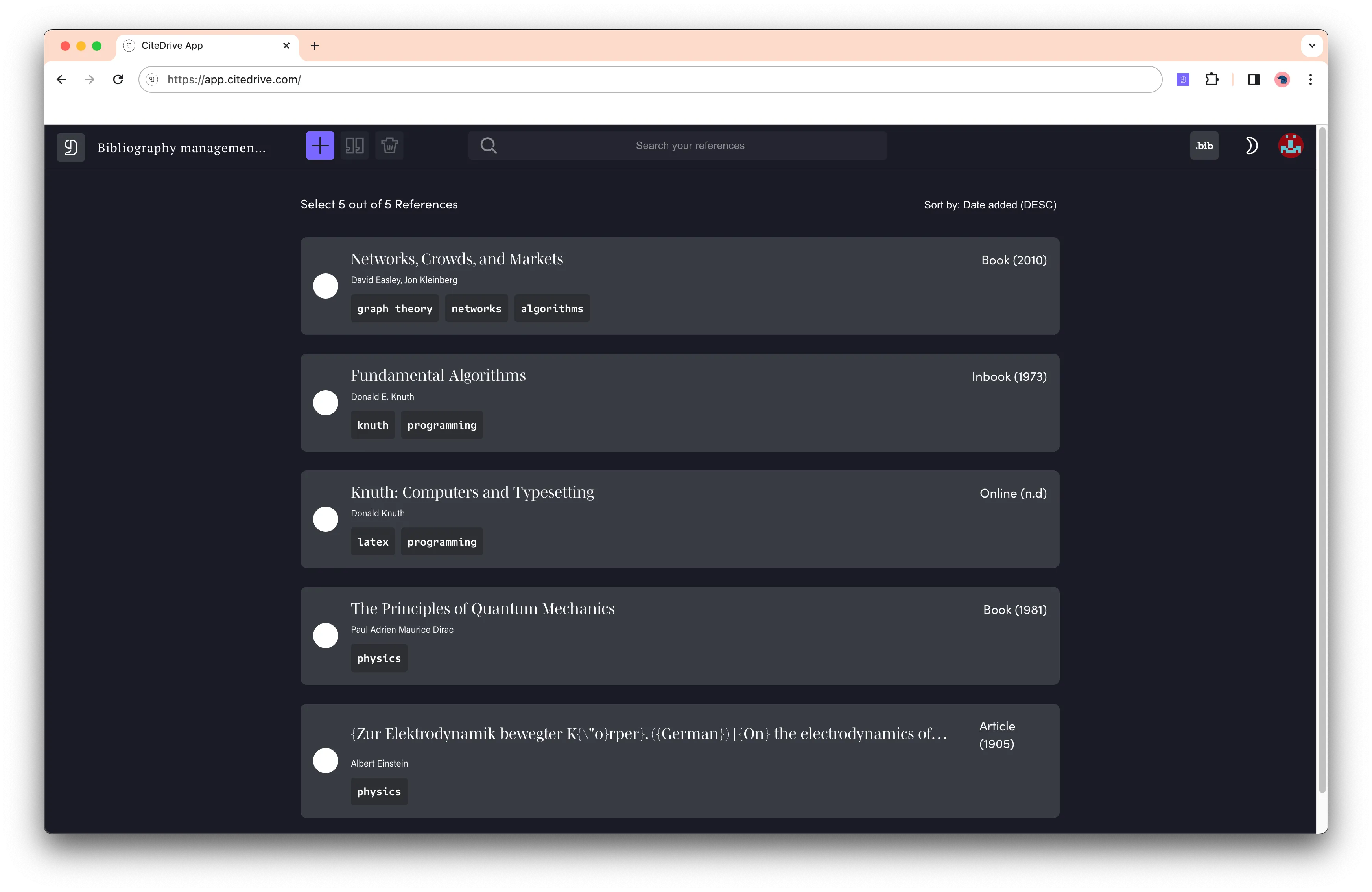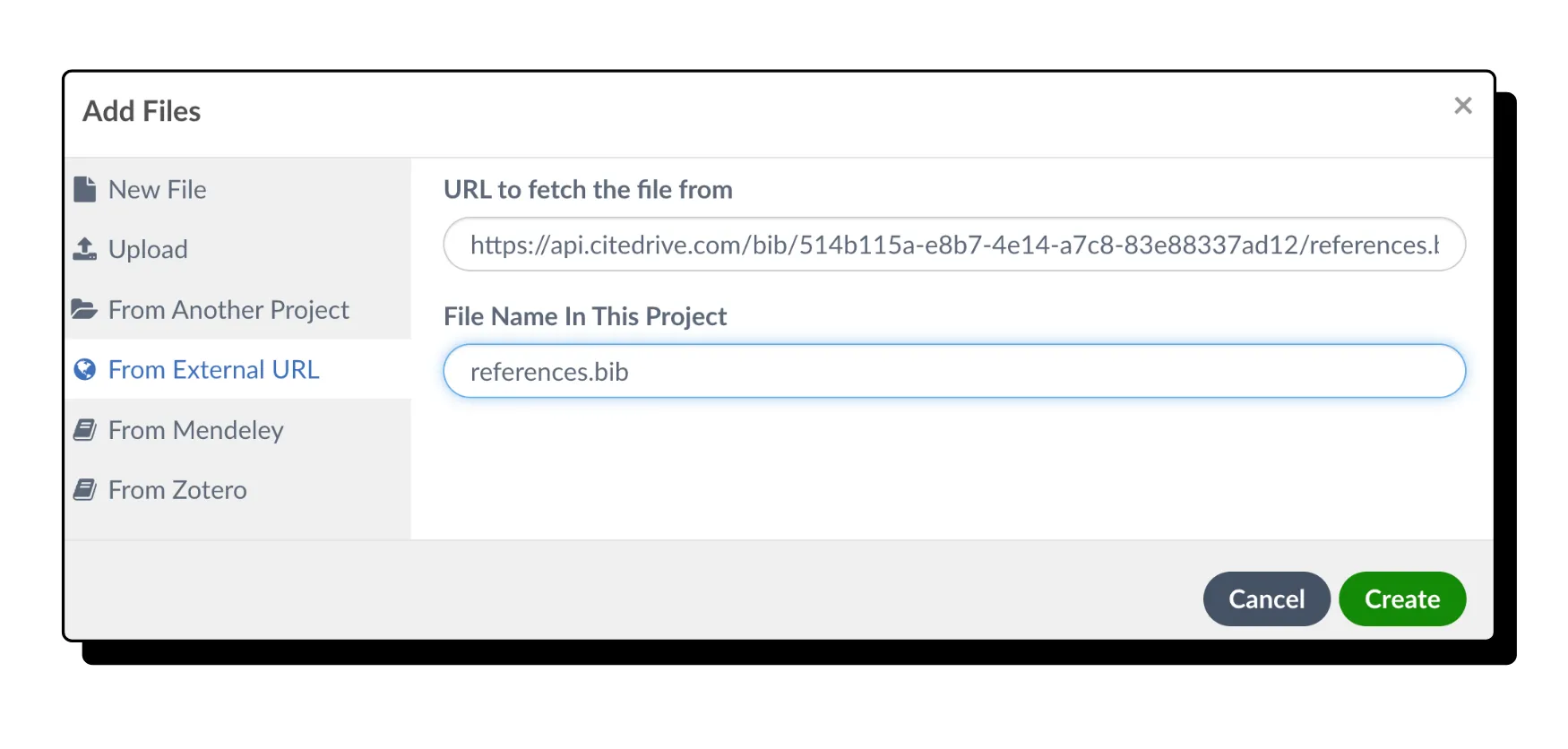Overleaf에서 인용 및 참고문헌 사용하기: 연구자를 위한 가이드
연구 논문을 작성할 때, 주장을 뒷받침하기 위해 참고문헌을 사용하는 것은 매우 중요합니다. 출처를 올바르게 인용하는 것이 강력한 주장을 만드는 핵심이며, 표절을 피할 수 있는 방법입니다. 이 가이드에서는 CiteDrive를 사용하여 Overleaf에서 참고문헌을 인용하는 방법을 보여드립니다. 또한 신뢰할 수 있는 출처를 온라인에서 찾는 방법에 대한 팁도 제공합니다. 시작해봅시다!
1단계: CiteDrive와 Overleaf 연결하기
먼저, 아직 Overleaf에 로그인하지 않았다면 로그인해야 합니다. 그런 다음, CiteDrive로 가서 Overleaf 프로젝트를 만들고, 새 프로젝트에 참고문헌 추가 합니다. 프로젝트는 다음과 같을 수 있습니다:

그 후, 프로젝트의 왼쪽 상단에서 “bib”을 클릭합니다. 이 작업을 통해, Overleaf에서 사용할 수 있는 동적 BibTeX 파일을 새 탭에서 열 수 있으며, 프로젝트에 있는 인용을 추가, 수정 또는 삭제할 때마다 자동으로 업데이트됩니다.
마지막으로, Overleaf로 가서 새 파일을 만들고, “From External URL”을 선택한 후 동적 BibTeX URL을 “URL to fetch the file from”에 붙여넣고, 이름을 references.bib으로 설정합니다. 이제 CiteDrive 프로젝트가 Overleaf와 연결되었습니다! 변경 사항을 적용할 때마다 Overleaf에서 최신 상태를 받으려면 “새로 고침”을 클릭해야 합니다.

2단계: Overleaf에서 TeX 문서 만들기
이제 Overleaf에서 새 tex 파일을 만들어 보겠습니다. 이 파일을 “document.tex”이라고 부를 수 있으며, \bibliography{references}를 사용하여 CiteDrive의 BibTeX 파일을 정의할 수 있습니다. 그런데 어떤 참고문헌 관리 도구를 사용해야 할까요? LaTeX/Overleaf에서 참고문헌 관리를 위한 여러 가지 옵션이 있습니다. 주로 natbib, bibtex, biblatex가 있습니다. LaTeX에서 참고문헌 관리를 위한 기본 도구는 BibTeX이며, natbib은 BibTeX에 추가 기능을 제공하여 인용을 더 자유롭게 디자인할 수 있게 해줍니다. biblatex는 BibTeX의 완전한 개정판으로, 더 많은 참고문헌 유형, 정렬 및 필터링 옵션, 로컬라이제이션 기능을 제공합니다. BibTeX는 가장 잘 알려진 프로그램이지만, BibLaTeX는 강력할 뿐만 아니라 신규 사용자에게 가장 추천되는 프로그램입니다. 참고문헌 및 인용 데이터는 .bib 파일에 저장되며, 이는 CiteDrive에서 제공하는 BibTeX 파일과 동일한 형식을 가집니다. 형식은 항상 다음과 같습니다:
@article{smith201X, title = {An interesting article}, author = {John Smith}, year = {201X}, journal = {Journal of Interesting Articles}}여기서 @article은 출처 유형이고, title, author, year, journal은 참고문헌 목록 및 인용에 표시될 속성이며, 마지막으로 smith201X는 문서에서 참조할 때 사용하는 고유한 식별자입니다. CiteDrive는 형식에 구애받지 않으며, 선택한 참고문헌 패키지에 맞게 어떤 필드와 항목 유형도 지원합니다. CiteDrive의 기본 목표는 참고문헌 데이터를 문서와 인용 스타일로부터 분리하는 것이기 때문에 모든 대안이 지원됩니다.
아래는 시작하는 데 도움이 될 세 가지 템플릿입니다.
BibTeX 시작하기:
BibTeX를 사용하고 싶다면, 아래 템플릿을 사용하거나 Overleaf에서 직접 열어보세요. BibTeX에 대한 자세한 정보는 문서를 참조하세요.
\documentclass{article}\usepackage[utf8]{inputenc}
\title{BibTeX references in \LaTeX}\author{John Smith}
\begin{document}
\maketitle
Lorem ipsum dolor sit amet, consectetur adipiscing elit. Praesent enim urna, dapibus et bibendum vel, consectetur et turpis. Cras a molestie nulla. \cite{Hemingway1952}\medskip
\bibliographystyle{unsrt}\bibliography{references}
\end{document}natbib 시작하기:
\documentclass{article}\usepackage{natbib}\bibliographystyle{apalike}\title{A Short Guide to Reference Management using natbib with BibTeX}\author{CiteDrive}\date {January 1988}
\begin{document}
\maketitle\textbf{Narrative citation:} \citet{Doe:1966} investigated the risks of incorrectly \\recorded [...], which results in distortion.\textbf{Parenthetical citation:} The risks of incorrect recording of [...] could lead to distortion\citep{Doe:1966}.
\medskip
\bibliography{references}
\end{document}natbib에 대한 더 자세한 정보는 여기를 클릭하세요.
BibLaTeX 시작하기:
\documentclass{article}\usepackage{biblatex}\addbibresource{references.bib}
\begin{document}Lorem ipsum dolor sit amet, consectetur adipiscing elit. Praesent enim urna, dapibus et bibendum vel, consectetur et turpis. Cras a molestie nulla. \cite{Hemingway1952}\medskip
\printbibliography
\end{document}BibLaTeX에 대한 더 자세한 정보는 여기를 클릭하세요.
3단계: 인용문 내에서 인용하기
브라우저 확장 프로그램을 설치한 경우, 텍스트를 선택하고 툴바에서 CiteDrive 아이콘을 클릭하여 인용을 만들 수 있습니다.
또한 \cite{smith201X}와 같이 cite 명령어를 사용하여 수동으로 인용할 수 있습니다. 또는 Overleaf에서 참조 검색을 사용할 수 있습니다.
Overleaf에는 참고문헌 스타일이 미리 설치되어 있으며, 사용한 패키지에 따라 인용 스타일이 자동으로 적용됩니다.
이로써 Overleaf에서 참고문헌을 사용하는 데 필요한 모든 것이 준비되었습니다. 질문이나 피드백이 있으면 hello@citedrive.com으로 이메일을 보내주세요.